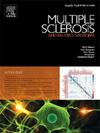Comparative effectiveness, persistence, and adherence of dimethyl fumarate and fingolimod in patients with multiple sclerosis in Japan: A cohort study
IF 2.9
3区 医学
Q2 CLINICAL NEUROLOGY
引用次数: 0
Abstract
Background
Several oral disease-modifying drugs (DMDs) for multiple sclerosis (MS) are available but only two – dimethyl fumarate (DMF) and fingolimod (FTY) – are approved for relapsing-remitting MS in Japan. Although the efficacy of DMDs might be affected by differences in genetic and environmental factors, no study has compared the effectiveness, treatment persistence, and adherence of DMF and FTY in Asians. Here, we assessed relapse rates, persistence, and adherence of DMF and FTY in a Japanese real-world setting.
Methods
A cohort study was conducted using a large Japanese claims database. We included MS patients aged ≥18 years who initiated DMF or FTY between February 22, 2017 (the launch of DMF in Japan), and February 29, 2020. The primary effectiveness outcome was MS relapse, defined as treatment with intravenous methylprednisolone at a dosage of ≥250 mg/day for at least 3 consecutive days. Annualized relapse rates (ARRs) and ARR ratios for DMF and FTY groups were estimated using a Poisson regression model. Secondary outcomes included persistence and adherence. Persistence was evaluated using Kaplan–Meier survival analysis and a Cox proportional hazards model. Adherence was assessed by the proportion of days covered (PDC) at 30, 60, 90, 180, and 365 days. Propensity score overlap weighting was used to adjust for baseline covariates between groups.
Results
143 patients in the DMF group (mean age 41.45 years, 59 males, mean number of MS relapses at baseline: 0.54) and 36 in the FTY group (mean age 39.89 years, 18 males, mean number of MS relapses at baseline: 0.56) met the eligibility criteria. After overlap weighting, covariates were well balanced. The ARR was 0.05 (95 % confidence interval, 0.02–0.16) in the DMF group and 0.15 (0.05–0.45) in the FTY group, with a ratio of 0.34 (0.07–1.63). The 1-year persistence was 0.84 (0.74–0.95) for the DMF group and 0.53 (0.37–0.78) for the FTY group, resulting in a hazard ratio of 0.28 (0.11–0.70). Median PDC for the DMF group was 0.90 (interquartile range, 0.77–1.00) at 30 days, which improved over time as treatment duration increased to reach 0.98 (0.94–0.98) at 365 days. In contrast, median PDC for the FTY group remained constant at 0.98–1.00 across all time points.
Conclusion
The effectiveness, as measured by ARRs, was comparable between the DMF and FTY groups, although a small but clinically significant difference may not have been detected in this study. Persistence was higher in the DMF group than in the FTY group. Adherence was high for both drugs, but some patients treated with DMF had low adherence early in treatment.
求助全文
约1分钟内获得全文
求助全文
来源期刊

Multiple sclerosis and related disorders
CLINICAL NEUROLOGY-
CiteScore
5.80
自引率
20.00%
发文量
814
审稿时长
66 days
期刊介绍:
Multiple Sclerosis is an area of ever expanding research and escalating publications. Multiple Sclerosis and Related Disorders is a wide ranging international journal supported by key researchers from all neuroscience domains that focus on MS and associated disease of the central nervous system. The primary aim of this new journal is the rapid publication of high quality original research in the field. Important secondary aims will be timely updates and editorials on important scientific and clinical care advances, controversies in the field, and invited opinion articles from current thought leaders on topical issues. One section of the journal will focus on teaching, written to enhance the practice of community and academic neurologists involved in the care of MS patients. Summaries of key articles written for a lay audience will be provided as an on-line resource.
A team of four chief editors is supported by leading section editors who will commission and appraise original and review articles concerning: clinical neurology, neuroimaging, neuropathology, neuroepidemiology, therapeutics, genetics / transcriptomics, experimental models, neuroimmunology, biomarkers, neuropsychology, neurorehabilitation, measurement scales, teaching, neuroethics and lay communication.
 求助内容:
求助内容: 应助结果提醒方式:
应助结果提醒方式:


